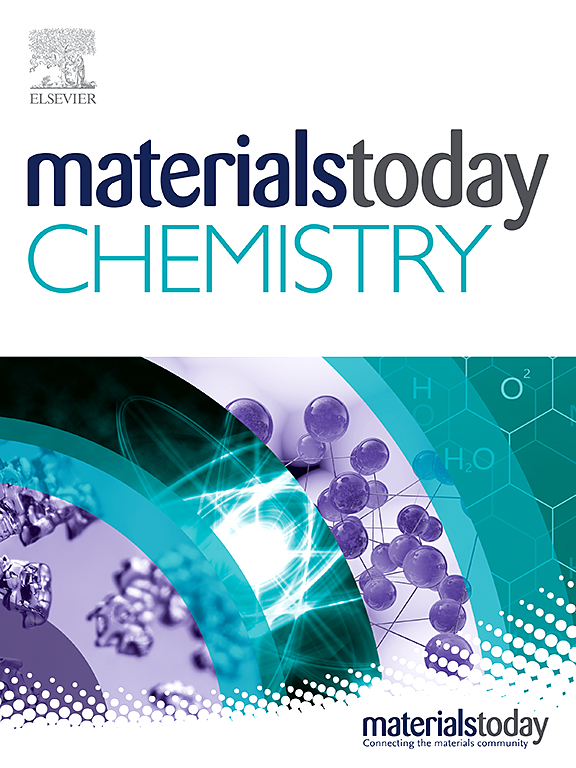基于纳米杂化技术的智能手机兼容型高性能电化学葡萄糖传感器
IF 6.7
2区 化学
Q1 CHEMISTRY, MULTIDISCIPLINARY
引用次数: 0
摘要
利用纳米杂化技术构建了一种成本低、电位低、与智能手机兼容的电化学传感器,用于检测人和动物血清中的葡萄糖。合成了由金纳米粒子(GNP)装饰的六氰基铁酸钴(CHCF)修饰的 ZIF-67(钴金属有机框架,CMOF)组成的纳米杂化物,并通过傅立叶变换红外光谱(FTIR)、X 射线衍射(XRD)和带有 EDX 分析的扫描电镜对其进行了表征。通过将纳米杂化物沉积在传统的玻璃碳电极(GCE)上并进行循环伏安法测试,研究了纳米杂化物的电化学特性,结果表明在 GNP-CHCF-CMOF 中存在一个形式电位为 +0.23 V 的稳定氧化还原峰,与钴氧化还原对偶相对应。因此,所开发的传感器被用于电化学葡萄糖检测,在 8.33 至 3793 μM 的线性检测范围内显示出卓越的电催化活性,在 +0.35 V 的低电位下,检测限低至 0.96 μM。此外,GNP-CHCF-CMOF/GCE 传感器还被用于检测人和兔子血清样品中的葡萄糖,其回收率极高。研究人员还制作了一种便携式测量装置,可在智能手机中实时监测葡萄糖。这种新方法为设计和制造具有成本效益的低电位传感器铺平了道路,从而降低了总体成本并提高了传感设备的性能。本文章由计算机程序翻译,如有差异,请以英文原文为准。
A nanohybrid-based smartphone-compatible high performance electrochemical glucose sensor
A cost-effective and low-potential smartphone-compatible electrochemical sensor was constructed using a nanohybrid for the sensing of glucose in human and animal serum. The nanohybrid composed of gold nanoparticle (GNP) decorated cobalt hexacyanoferrate (CHCF) modified ZIF-67 (cobalt metal organic framework, CMOF) was synthesized and characterized by FTIR, XRD, and SEM with EDX analysis. The electrochemical characteristics of the nanohybrid were investigated by depositing the nanohybrid over a conventional glassy carbon electrode (GCE) and performing cyclic voltammetry, which revealed a stable redox peak with a formal potential of +0.23 V, corresponding to Co redox couple in GNP–CHCF–CMOF. Thus, developed sensor was utilized for the electrochemical glucose detection, which showed exceptional electrocatalytic activity over a linear detection range from 8.33 to 3793 μM with a low detection limit of 0.96 μM at a low potential of +0.35 V. Furthermore, the GNP–CHCF–CMOF/GCE sensor was employed for the detection of glucose spiked in human and rabbit serum samples, which showed excellent recoveries. A portable measurement device was fabricated which showed the real-time monitoring of glucose in a smartphone. This novel approach paves the way for the design and fabrication of cost-effective, low-potential sensors, which would reduce overall costs and enhance the performance of sensing devices.
求助全文
通过发布文献求助,成功后即可免费获取论文全文。
去求助
来源期刊

Materials Today Chemistry
Multiple-
CiteScore
8.90
自引率
6.80%
发文量
596
审稿时长
33 days
期刊介绍:
Materials Today Chemistry is a multi-disciplinary journal dedicated to all facets of materials chemistry.
This field represents one of the fastest-growing areas of science, involving the application of chemistry-based techniques to the study of materials. It encompasses materials synthesis and behavior, as well as the intricate relationships between material structure and properties at the atomic and molecular scale. Materials Today Chemistry serves as a high-impact platform for discussing research that propels the field forward through groundbreaking discoveries and innovative techniques.
 求助内容:
求助内容: 应助结果提醒方式:
应助结果提醒方式:


